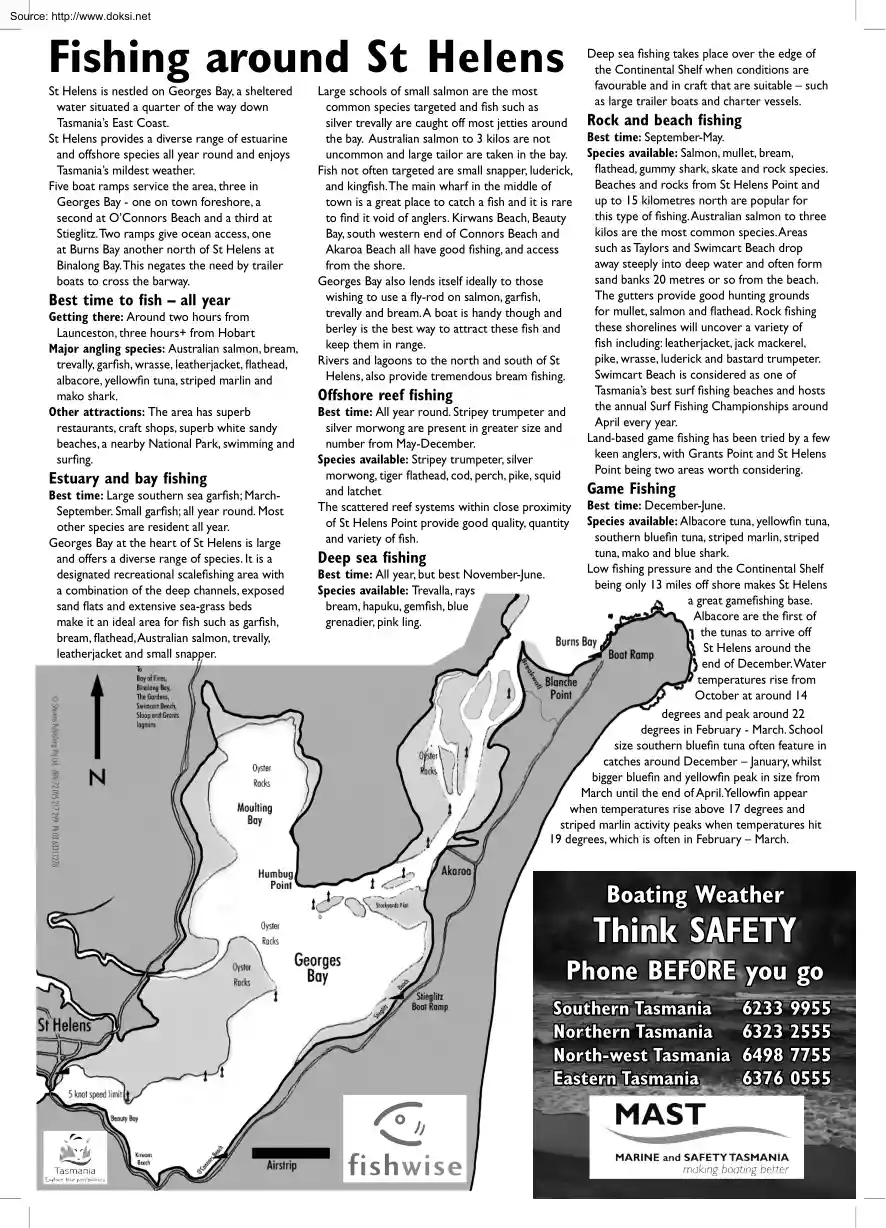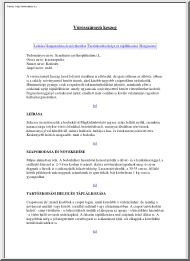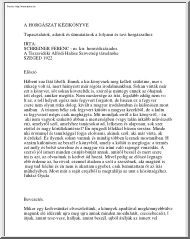Datasheet
Year, pagecount:2010, 2 page(s)
Language:English
Downloads:2
Uploaded:May 14, 2018
Size:1 MB
Institution:
-
Comments:
Attachment:-
Download in PDF:Please log in!
Comments
No comments yet. You can be the first!Most popular documents in this category
Content extract
Source: http://www.doksinet Fishing around St Helens St Helens is nestled on Georges Bay, a sheltered water situated a quarter of the way down Tasmania’s East Coast. St Helens provides a diverse range of estuarine and offshore species all year round and enjoys Tasmania’s mildest weather. Five boat ramps service the area, three in Georges Bay - one on town foreshore, a second at O’Connors Beach and a third at Stieglitz. Two ramps give ocean access, one at Burns Bay another north of St Helens at Binalong Bay. This negates the need by trailer boats to cross the barway. Best time to fish – all year Getting there: Around two hours from Launceston, three hours+ from Hobart Major angling species: Australian salmon, bream, trevally, garfish, wrasse, leatherjacket, flathead, albacore, yellowfin tuna, striped marlin and mako shark. Other attractions: The area has superb restaurants, craft shops, superb white sandy beaches, a nearby National Park, swimming and surfing. Estuary and bay
fishing Best time: Large southern sea garfish; MarchSeptember. Small garfish; all year round Most other species are resident all year. Georges Bay at the heart of St Helens is large and offers a diverse range of species. It is a designated recreational scalefishing area with a combination of the deep channels, exposed sand flats and extensive sea-grass beds make it an ideal area for fish such as garfish, bream, flathead, Australian salmon, trevally, leatherjacket and small snapper. Large schools of small salmon are the most common species targeted and fish such as silver trevally are caught off most jetties around the bay. Australian salmon to 3 kilos are not uncommon and large tailor are taken in the bay. Fish not often targeted are small snapper, luderick, and kingfish. The main wharf in the middle of town is a great place to catch a fish and it is rare to find it void of anglers. Kirwans Beach, Beauty Bay, south western end of Connors Beach and Akaroa Beach all have good fishing,
and access from the shore. Georges Bay also lends itself ideally to those wishing to use a fly-rod on salmon, garfish, trevally and bream. A boat is handy though and berley is the best way to attract these fish and keep them in range. Rivers and lagoons to the north and south of St Helens, also provide tremendous bream fishing. Offshore reef fishing Best time: All year round. Stripey trumpeter and silver morwong are present in greater size and number from May-December. Species available: Stripey trumpeter, silver morwong, tiger flathead, cod, perch, pike, squid and latchet The scattered reef systems within close proximity of St Helens Point provide good quality, quantity and variety of fish. Deep sea fishing takes place over the edge of the Continental Shelf when conditions are favourable and in craft that are suitable – such as large trailer boats and charter vessels. Rock and beach fishing Best time: September-May. Species available: Salmon, mullet, bream, flathead, gummy
shark, skate and rock species. Beaches and rocks from St Helens Point and up to 15 kilometres north are popular for this type of fishing. Australian salmon to three kilos are the most common species. Areas such as Taylors and Swimcart Beach drop away steeply into deep water and often form sand banks 20 metres or so from the beach. The gutters provide good hunting grounds for mullet, salmon and flathead. Rock fishing these shorelines will uncover a variety of fish including: leatherjacket, jack mackerel, pike, wrasse, luderick and bastard trumpeter. Swimcart Beach is considered as one of Tasmania’s best surf fishing beaches and hosts the annual Surf Fishing Championships around April every year. Land-based game fishing has been tried by a few keen anglers, with Grants Point and St Helens Point being two areas worth considering. Game Fishing Stevens Publishing Pty Ltd. ABN 72 095 217 299 Ph 03 63311278 Best time: December-June. Species available: Albacore tuna, yellowfin tuna,
southern bluefin tuna, striped marlin, striped tuna, mako and blue shark. Deep sea fishing Low fishing pressure and the Continental Shelf Best time: All year, but best November-June. being only 13 miles off shore makes St Helens Species available: Trevalla, rays a great gamefishing base. bream, hapuku, gemfish, blue Albacore are the first of grenadier, pink ling. the tunas to arrive off St Helens around the end of December. Water temperatures rise from October at around 14 degrees and peak around 22 degrees in February - March. School size southern bluefin tuna often feature in catches around December – January, whilst bigger bluefin and yellowfin peak in size from March until the end of April.Yellowfin appear when temperatures rise above 17 degrees and striped marlin activity peaks when temperatures hit 19 degrees, which is often in February – March. Boating Weather Think SAFETY Phone BEFORE you go Southern Tasmania 6233 Northern Tasmania 6323 North-west Tasmania 6498
Eastern Tasmania 6376 9955 2555 7755 0555 Source: http://www.doksinet Going Fishing? Fish for the Future! Fish Responsibly - keep informed with the Recreational Sea Fishing Guide and use a fish measuring ruler. Illustration Peter Gouldthorpe The Guides and fish measuring rulers are available from all Service Tasmania outlets and major tackle shops. Information can also be found by visiting: www.fishingtasgovau 10357GD Fishing Restrictions in Tasmania This pamphlet provides only basic fishing information. For more detailed information about marine fishing rules including area restrictions, size and possession limits, refer to the Recreational Sea Fishing Guide and for inland fishing, to the Tasmanian Inland Recreational Fishing Code. These are available from Service Tasmania outlets and most bait and tackle shops. They can also be downloaded at www.fishing tas.govau or wwwifstasgovau respectively. Rod and Line Fishing You do not need a licence to fish with a hook and line in
marine waters, including rod and line and squid jigs. You can use any number of lines with up to 5 hooks as long as you are within 20 metres of your gear or the lines are attached to the boat from which you are fishing. A set line licence is needed to use a set line which is a dropline or longline with up to 30 hooks. Licences for Inland Waters An Inland Fisheries licence is required for any fishing in inland waters which includes some river mouths and estuaries. Inland waters and seaward limits are described in the Recreational Sea Fishing Guide and the Inland Recreational Fishing Code. Licences for Marine Waters In marine waters a licence is not required for fishing with a rod and line, squid jigs, spears, bait traps, small nets (landing, dip, bait and cast nets), or collection of small shellfish such as periwinkles, oysters, clams, cockles and mussels. Sea fishing licences are required when fishing for abalone, rock lobster and scallop or fishing with a pot, ring, graball net,
mullet net, beach seine net and set line (a longline or dropline with up to 30 hooks). Recreational sea fishing licences are available from all Service Tasmania outlets and on the internet at www.fishingtasgovau/licence Aborigines engaged in aboriginal fishing activities are exempt from holding a fishing licence but must comply with all other fisheries rules. Useful Contacts Recreational Sea Fishing ( Wild Fisheries Management Branch) inc Fishcare: 6233 7042 www.fishingtasgovau Inland Fisheries Service: 1300 463 474 www.ifstasgovau Marine and Safety Tasmania: 6233 8801 www.masttasgovau Marine Police and Fishwatch: 0427 655 557 Bureau of Meterology: www.bomgovau Bag and Possession Limits Most bag and possession limits are personal limits, although boat and on water limits apply for some species. Possession limits apply everywhere, including in the boat, at sea and in your home. Fishwise – licence fees are used to benefit our fisheries The
Fishwise fund is supported by the sale of recreational sea fishing licences. It covers the administration of licences as well as funding programs that support recreational fishing. The majority of funding for this pamphlet is from the Fishwise Fund. Your sea fishing licence fees at work! Seasons and Area Restrictions Season apply to most inland waters. In marine waters, closed seasons and area closure apply to taking various species and using particular fishing gear. Fishcare Volunteers Fishcare Volunteers are enthusiastic individuals who give up their time to educate members of the recreational fishing community. Volunteers are well versed in the rules relating to recreational marine fishing and are happy to answer queries that you may have. If you are interested in finding out more about the Fishcare Tasmania program, please visit our website at www.fishingtasgovau or call 6233 2033
fishing Best time: Large southern sea garfish; MarchSeptember. Small garfish; all year round Most other species are resident all year. Georges Bay at the heart of St Helens is large and offers a diverse range of species. It is a designated recreational scalefishing area with a combination of the deep channels, exposed sand flats and extensive sea-grass beds make it an ideal area for fish such as garfish, bream, flathead, Australian salmon, trevally, leatherjacket and small snapper. Large schools of small salmon are the most common species targeted and fish such as silver trevally are caught off most jetties around the bay. Australian salmon to 3 kilos are not uncommon and large tailor are taken in the bay. Fish not often targeted are small snapper, luderick, and kingfish. The main wharf in the middle of town is a great place to catch a fish and it is rare to find it void of anglers. Kirwans Beach, Beauty Bay, south western end of Connors Beach and Akaroa Beach all have good fishing,
and access from the shore. Georges Bay also lends itself ideally to those wishing to use a fly-rod on salmon, garfish, trevally and bream. A boat is handy though and berley is the best way to attract these fish and keep them in range. Rivers and lagoons to the north and south of St Helens, also provide tremendous bream fishing. Offshore reef fishing Best time: All year round. Stripey trumpeter and silver morwong are present in greater size and number from May-December. Species available: Stripey trumpeter, silver morwong, tiger flathead, cod, perch, pike, squid and latchet The scattered reef systems within close proximity of St Helens Point provide good quality, quantity and variety of fish. Deep sea fishing takes place over the edge of the Continental Shelf when conditions are favourable and in craft that are suitable – such as large trailer boats and charter vessels. Rock and beach fishing Best time: September-May. Species available: Salmon, mullet, bream, flathead, gummy
shark, skate and rock species. Beaches and rocks from St Helens Point and up to 15 kilometres north are popular for this type of fishing. Australian salmon to three kilos are the most common species. Areas such as Taylors and Swimcart Beach drop away steeply into deep water and often form sand banks 20 metres or so from the beach. The gutters provide good hunting grounds for mullet, salmon and flathead. Rock fishing these shorelines will uncover a variety of fish including: leatherjacket, jack mackerel, pike, wrasse, luderick and bastard trumpeter. Swimcart Beach is considered as one of Tasmania’s best surf fishing beaches and hosts the annual Surf Fishing Championships around April every year. Land-based game fishing has been tried by a few keen anglers, with Grants Point and St Helens Point being two areas worth considering. Game Fishing Stevens Publishing Pty Ltd. ABN 72 095 217 299 Ph 03 63311278 Best time: December-June. Species available: Albacore tuna, yellowfin tuna,
southern bluefin tuna, striped marlin, striped tuna, mako and blue shark. Deep sea fishing Low fishing pressure and the Continental Shelf Best time: All year, but best November-June. being only 13 miles off shore makes St Helens Species available: Trevalla, rays a great gamefishing base. bream, hapuku, gemfish, blue Albacore are the first of grenadier, pink ling. the tunas to arrive off St Helens around the end of December. Water temperatures rise from October at around 14 degrees and peak around 22 degrees in February - March. School size southern bluefin tuna often feature in catches around December – January, whilst bigger bluefin and yellowfin peak in size from March until the end of April.Yellowfin appear when temperatures rise above 17 degrees and striped marlin activity peaks when temperatures hit 19 degrees, which is often in February – March. Boating Weather Think SAFETY Phone BEFORE you go Southern Tasmania 6233 Northern Tasmania 6323 North-west Tasmania 6498
Eastern Tasmania 6376 9955 2555 7755 0555 Source: http://www.doksinet Going Fishing? Fish for the Future! Fish Responsibly - keep informed with the Recreational Sea Fishing Guide and use a fish measuring ruler. Illustration Peter Gouldthorpe The Guides and fish measuring rulers are available from all Service Tasmania outlets and major tackle shops. Information can also be found by visiting: www.fishingtasgovau 10357GD Fishing Restrictions in Tasmania This pamphlet provides only basic fishing information. For more detailed information about marine fishing rules including area restrictions, size and possession limits, refer to the Recreational Sea Fishing Guide and for inland fishing, to the Tasmanian Inland Recreational Fishing Code. These are available from Service Tasmania outlets and most bait and tackle shops. They can also be downloaded at www.fishing tas.govau or wwwifstasgovau respectively. Rod and Line Fishing You do not need a licence to fish with a hook and line in
marine waters, including rod and line and squid jigs. You can use any number of lines with up to 5 hooks as long as you are within 20 metres of your gear or the lines are attached to the boat from which you are fishing. A set line licence is needed to use a set line which is a dropline or longline with up to 30 hooks. Licences for Inland Waters An Inland Fisheries licence is required for any fishing in inland waters which includes some river mouths and estuaries. Inland waters and seaward limits are described in the Recreational Sea Fishing Guide and the Inland Recreational Fishing Code. Licences for Marine Waters In marine waters a licence is not required for fishing with a rod and line, squid jigs, spears, bait traps, small nets (landing, dip, bait and cast nets), or collection of small shellfish such as periwinkles, oysters, clams, cockles and mussels. Sea fishing licences are required when fishing for abalone, rock lobster and scallop or fishing with a pot, ring, graball net,
mullet net, beach seine net and set line (a longline or dropline with up to 30 hooks). Recreational sea fishing licences are available from all Service Tasmania outlets and on the internet at www.fishingtasgovau/licence Aborigines engaged in aboriginal fishing activities are exempt from holding a fishing licence but must comply with all other fisheries rules. Useful Contacts Recreational Sea Fishing ( Wild Fisheries Management Branch) inc Fishcare: 6233 7042 www.fishingtasgovau Inland Fisheries Service: 1300 463 474 www.ifstasgovau Marine and Safety Tasmania: 6233 8801 www.masttasgovau Marine Police and Fishwatch: 0427 655 557 Bureau of Meterology: www.bomgovau Bag and Possession Limits Most bag and possession limits are personal limits, although boat and on water limits apply for some species. Possession limits apply everywhere, including in the boat, at sea and in your home. Fishwise – licence fees are used to benefit our fisheries The
Fishwise fund is supported by the sale of recreational sea fishing licences. It covers the administration of licences as well as funding programs that support recreational fishing. The majority of funding for this pamphlet is from the Fishwise Fund. Your sea fishing licence fees at work! Seasons and Area Restrictions Season apply to most inland waters. In marine waters, closed seasons and area closure apply to taking various species and using particular fishing gear. Fishcare Volunteers Fishcare Volunteers are enthusiastic individuals who give up their time to educate members of the recreational fishing community. Volunteers are well versed in the rules relating to recreational marine fishing and are happy to answer queries that you may have. If you are interested in finding out more about the Fishcare Tasmania program, please visit our website at www.fishingtasgovau or call 6233 2033





 When reading, most of us just let a story wash over us, getting lost in the world of the book rather than paying attention to the individual elements of the plot or writing. However, in English class, our teachers ask us to look at the mechanics of the writing.
When reading, most of us just let a story wash over us, getting lost in the world of the book rather than paying attention to the individual elements of the plot or writing. However, in English class, our teachers ask us to look at the mechanics of the writing.